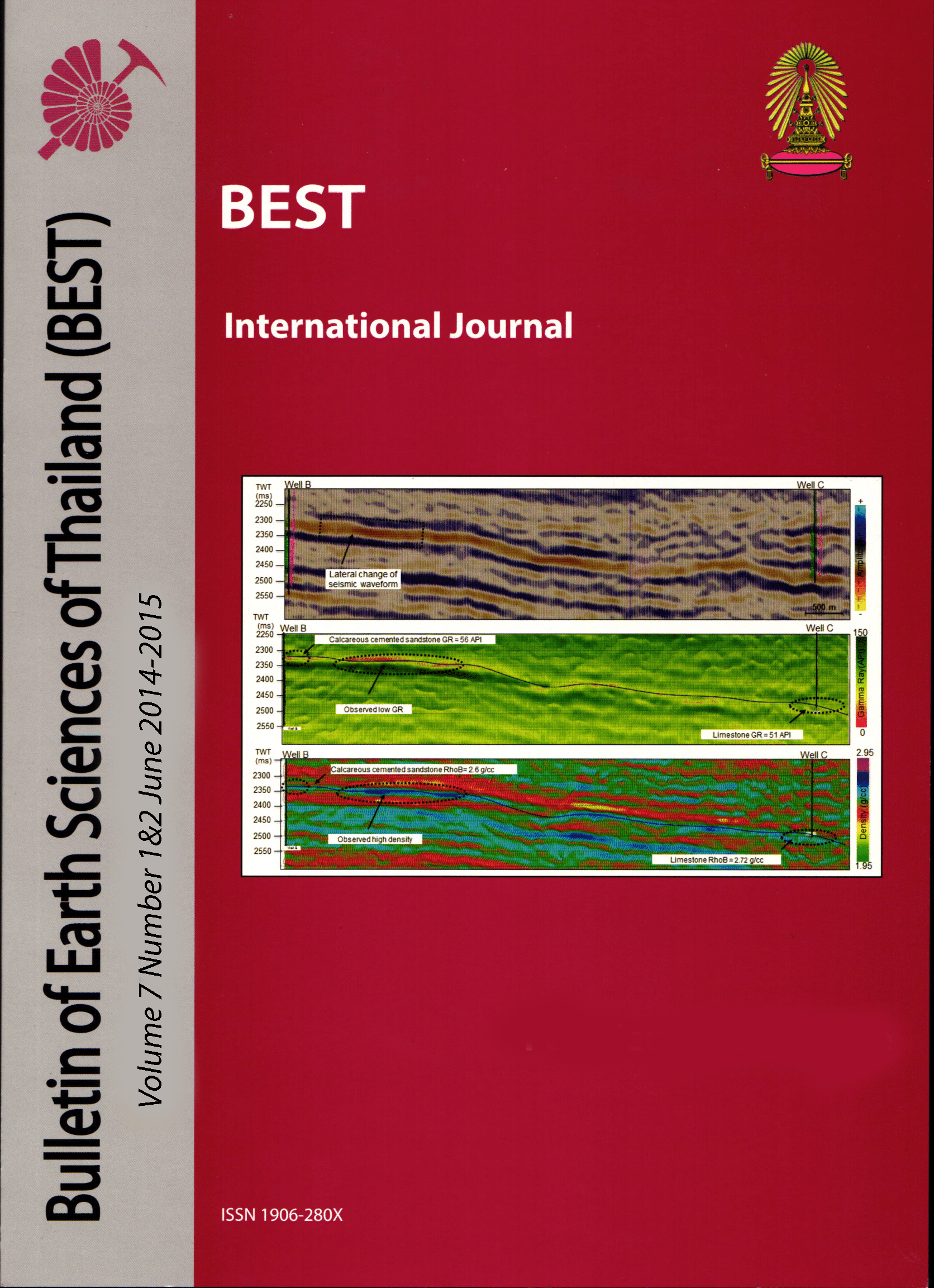Fluid Evolution through Different Deformation Stages: A carbonate outcrop-based study in the Western Highland of Thailand
Main Article Content
Abstract
Veins offer the opportunity to study the burial and thermal evolution of rocks in complex geological settings. This study aims to determine the fluid evolution in Sibumasu block of Thailand in the context of structural deformation using a framework of texture-specific stable isotope sampling, controlled by field mapping and structural measurements. Structural measurements were taken and related rock samples were collected from two outcrops within the shear zone of the Three Pagoda Fault Zone (TPFZ). These meas-urements were then integrated via a combination of structural stereo plots, petrographic analyses and carbon-oxygen stable isotope determinations. Veins observed have wideranging orientations and show cross-cutting relationships. Vein orientations cluster into two groups: 1) sub-horizontal with NNW-SSE orienta-tions and 2) sub-vertical with ENE-WSW orientations. The cross-cutting relationships were validated by petrographic analysis. All veins are syntaxial and made up of different mineralogies (ferroan-calcite, calcite, dolomite and silica). Isotopes sampled from veins define three different data fields. These distinct isotope clusters relate to different vein orientations and ultimately are interpreted to be responses to different deformation events. Some of the isotopic signatures are consistent with established burial trend for the Indochina block of Thailand. Veins in clusters 1 and 2, are interpreted to have precipitated from fluids in a closed subsurface hydrological system where rock-fluid crossflows dominated. These earlier veins likely formed during deformation related to the Indosinian Orogeny. When all matrix porosity and permeability was obliterated in deep burial, fluid flow became confined to tectonic fractures. Veins in cluster 3 precipitated from hotter fluids in deep pressurised settings with no rock-fluid cross flow in the adjacent rock matrix. These fluids were probably derived from a deeper source. These cluster 3 veins have an isotope signature that may have formed in the early Palaeogene, concomitant with the Himalayan orogeny as India commenced docking with Asia. This created hot fluid crossflows in fracture sets created by transpressional deformation along the Three Pagodas fault.
Article Details

This work is licensed under a Creative Commons Attribution-NonCommercial-NoDerivatives 4.0 International License.
Copyright © 2008 Department of Geology, Faculty of Science, Chulalongkorn University. Parts of an article can be photocopied or reproduced without prior written permission from the author(s), but due acknowledgments should be stated or cited accordingly.
References
Cuong, T. X., and J. K. Warren, 2009. Bach Ho Field, a fractured granitic basement reservoir, Cuu Long Basin, offshore SE Vietnam: A “buried-hill” play. Journal of Petroleum Geology, v. 32, p. 129-156.
Dietrich, D., J. A. McKenzie, and S. Honglin, 1983. Origin of calcite in syntectonic veins as determined from carbon- isotope ratios (Swizterland). Geology, v. 11, p. 547-551.
Lacassin, R., H. Maluski, P. H. Leloup, P. Tapponnier, C. Hinthong, K. Siribhakdi, S. Chuaviroj, and A. Charoenravat, 1997. Tertiary diachronic extrusion and deformation of western Indochina: structural and 40Ar/39Ar evidence from NW Thailand: Journal of Geophysical Research. Solid Earth (1978–2012), v. 102, p. 10013-10037.
Molnar, P., and P. Tapponnier, 1975. Cenozoic tectonics of Asia: effects of a continental collision. Science, v. 189, p. 419-426.
Morley, C. K., 2002. A tectonic model for the Tertiary evolution of strike – slip faults and rift basins in SE Asia. Tectonophysics, v. 347, p. 189-215.
Morley, C. K., 2007. Variations in Late Cenozoic–Recent strike-slip and oblique-extensional geometries, within Indochina: The influence of pre-existing fabrics. Journal of Structural Geology, v. 29, p. 36-58.
Morley, C. K., P. Ampaiwan, S. Thanudamrong, N. Kuenphan, and J. Warren, 2013. Development of the Khao Khwang Fold and Thrust Belt: mplications for the geodynamic setting of Thailand and Cambodia during the Indosinian Orogeny. Journal of Asian Earth Sciences, v. 62, p. 705-719.
Morley, C. K., P. Charusiri, and I. M. Watkinson, 2011. Structural geology of Thailand during the Cenozoic, in Michael F. Ridd, A. J. Barber, and M. J. Crow, eds., The Geology of Thailand, Geological Society of London, p. 273-334.
Nantasin, P., C. Hauzenberger, X. Liu, K. Krenn, Y. Dong, M. Thöni, and P. Wathanakul, 2012. Occurrence of the high grade Thabsila metamorphic com-plex within the low grade Three Pagodas shear zone, Kanchanaburi Province, western Thailand: Petrology and geochronology. Journal of Asian Earth Sciences, v. 60, p. 68–87.
Rhodes, B. P., P. Charusri, S. Kosuwan, and A. Lamjuan, 2005. Tertiary Evolution of the Three Pagodas Fault, Western Thailand, in Proceedings of the International Conference on Geology, Geotechnology and Mineral Resources of Indochina. Khon Kaen University, Khon Kaen: p. 498–505.
Sone, M., and I. Metcalfe, 2008. Parallel Tethyan sutures in mainland Southeast Asia: New insights for Palaeo-Tethys closure and implications for the Indosinian orogeny. Comptes Rendus Geoscience, v. 340, p. 166-179.
Tapponnier, P., G. Peltzer, and R. Armijo, 1986. On the mechanics of the collision between India and Asia: Geological Society London Special Publications, v. 19, p. 113-157.
Warren, J., C. K. Morley, T. Charoentitirat, I. Cartwright, P. Ampaiwan, P. Khositchaisri, M. Mirzaloo, and J. Yingyuen, 2014. Structural and fluid evolution of Saraburi Group sedimentary carbonates, central Thailand: A tec-tonically driven fluid system. Marine and Petroleum Geology, v. 55, p. 100-121.


